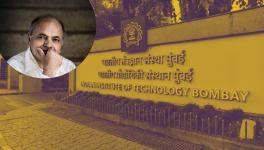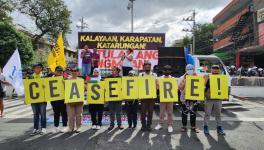Pegasus Tracking Reporters Portends Dark Future for Indian Journalism
Government snooping on journalists is an ominous sign for journalism in India. It invades their privacy, could kill their stories and compromise their sources, writes ANINDA DEY.
SNOOPGATE has revealed a dystopian Indian version of the mythical Greek monster slayer Bellerophon who rode the mythical winged horse Pegasus to kill the monstrous Chimera. It is the Indian government which in the saddle of the Trojan horse, scudding surreptitiously to hack phones of journalists.
Snooping on journalists is common in repressive regimes such as Saudi Arabia and the UAE. But the use of the Israeli NSO Group’s military-grade spyware by the world’s largest democracy to hack the phones of investigative reporters is the last nail in the coffin of journalism in India. It is all the more dangerous when a pliant and spineless media—except for a few organisations—is kowtowing to the Centre.
Also read: Pegasus: The new global weapon for silencing journalists
Paris-based non-profit Forbidden Stories and Amnesty International’s Security Lab coordinated with more than 80 journalists from 17 media outlets in 10 countries to reveal the most horrifying spectacle of the Pegasus Project: hacking of phones of journalists.
The presence of phone numbers of more than 40 Indian journalists—some of whom were bugged—in the leaked list of around 200 scribes in 20 countries of potential Pegasus targets is a chilling reminder of a Gestapo and Stasi-like mass surveillance.
While the government is fulminating against the dramatic revelation and has denied any unauthorised interception, the facts state the opposite.
The NSO Group’s criterion for selling the cyber mercenary and Toronto-based interdisciplinary laboratory The Citizen Lab’s 2018 report clearly show India uses Pegasus. Significantly, the Modi government has not denied using the malware even once.
Also read: The NSO Group behind Pegasus list & its murky past—from Mexico to Jamal Khashoggi to India
According to the Israeli company, the spyware is sold only to military, law enforcement and intelligence agencies of vetted governments to counter criminals and terrorists. Evidently, a government agency used it for surveillance on journalists. In 2018, Citizen Lab discovered suspected Pegasus infections in 33 of the 36 operators identified in its list of 45 countries which included India.
Snooping dangerous both for reporters and sources
With only a few unbiased Indian media outlets reporting facts, snooping on investigative journalists and critical commentators portends a dangerous future for journalism. Spying on investigative reporters, whose meticulous and gruelling work exposes government scams and scandals, is not only dangerous for the messenger but also compromises their sources of information. If it were not for such reporters, such information would remain buried in the labyrinth of files in the corridors of power.
Pegasus can be used by government agencies to extract details of crucial discussions or messages sent/received by the reporter on the collection of evidence or conversation about an impending scam or scandal. Snoops could relay such valuable information to the government, which can erase/hide evidence or remove electronic trails to prevent an exposé.
The lives of investigative reporters who are hounded and tracked could be at risk since their reportage could be damaging to the government or its election prospects. Such reporters assiduously cultivate their sources both inside and outside the government and the party in power for years.
Also read: Journalism in India: A Dangerous Pursuit?
Their sources could include disgruntled ministers, sidelined party apparatchiks, officials helming important departments and agencies, NGOs, human rights groups and social activists. These sources could be either targeted or silenced if they are found to have supplied damaging information to reporters.
A dangerous country for journalists
The leaked database of potential targets of surveillance includes phone numbers of two founding editors of The Wire, its diplomatic editor and two of its regular contributors and a former journalist of The Indian Express.
According to Amnesty International, every major media outlet in India was selected as a potential target between 2017-2021. Forensic tests by Security Lab revealed that the phones of Siddharth Varadarajan and MK Venu, co-founders of The Wire, were hacked in June and senior independent journalist Paranjoy Guha Thakurta’s in 2018.
“Putting surveillance on a journalist has a very strong chilling effect,” Carlos Martinez de la Serna, programme director at the Committee to Protect Journalists, told Forbidden Stories. “This is a very, very important problem that everyone needs to take seriously—not only in context of where journalists are working in a hostile environment for journalism, but in the US and Western Europe and other places.”
India is considered “one of the world’s most dangerous countries for journalists trying to do their job properly”, according to Paris-based non-profit Reporters Without Borders (RSF). The NGO has painted a very grim picture of journalism in India after Narendra Modi came to power. “They are exposed to every kind of attack, including police violence against reporters, ambushes by political activists, and reprisals instigated by criminal groups or corrupt local officials,” it says.
When the government is desperately trying to quell dissent and undermine the freedom of the press like autocratic despotic regimes, the use of Pegasus to hack the phones of journalists is the gravest threat to the media.
Amnesty International secretary-general Agnes Callamard’s comment of how the lives of such journalists and their families in several countries are in danger following the massive data leak is frightening. “The numbers vividly show the abuse is widespread, placing journalists’ lives, those of their families and associates in danger, undermining freedom of the press and shutting down critical media. It is about controlling public narrative, resisting scrutiny, [and] suppressing any dissenting voice,” Callamard says.
RSF secretary-general Christophe Deloire finds Pegasus a vile and loathsome tool prized by its list of 37 ‘predators of press freedom’, which includes Modi.
“This is appalling. The revelations about the use of the Pegasus spyware inspire shock and revulsion given the extent of the surveillance and targeting of journalists,” he said after the data leak stormed newsrooms across the world.
RSF had sounded the alarm about Pegasus way back in 2017 after it was used to snoop on Mexican journalists and subsequently branded the NSO Group as a “digital predator” in 202O.
In a country whose ruling party is intolerant of any form of dissent or opposition to its ideology and policies and where only less than 40% of the citizens consider the freedom of the press very important, the future of journalism looks bleak.
BJP muzzling the media
A Pew Research Center survey conducted in 34 countries from 13 May to 2 October 2, 2019, totalling 38,426 respondents, discovered that only an abysmal 37% of Indians think it’s very important to have a media without censorship as against majorities across Europe, North America and Latin America that batted for the freedom of the press with Greece at 89%.
A large segment of the population no longer receives unbiased media coverage because of increasing government interference and suppression of facts. The message is clear: the media should not hold the government accountable.
The Bharatiya Janata Party’s (BJP) right-wing populism, massive support base, vicious troll army and the increasing politicisation of government institutions have created an alternate world of reality. The government has propounded an unproven theory of a conspiracy hatched by liberal elites, critical media and unidentified countries to destabilise India.
Derogatory terms such as “sickular” and “presstitutes’ are used for journalists who question the BJP’s hyper-nationalism and populism and for women reporters, respectively, on social media.
The NGO Freedom House, which conducts research and advocacy on democracy, political freedom and human rights, in its 2019 report ‘Media Freedom: A Downward Spiral’ says BJP-aligned “thugs have raided critical journalists’ homes and offices. The government has also been selective in the allocation of television licenses, effectively excluding unfriendly outlets from the airwaves”.
There has been a spike in cases lodged against journalists in the last decade, especially in BJP-ruled states since 2017. The Unlawful Activities (Prevention) Act, the Official Secrets Act, the Indian Penal Code, the Information Technology Act, the Disaster Management Act, the Epidemic Diseases Act and Section 144 of the Criminal Procedure Code are often slapped on scribes.
Rise in numbers of journalists arrested
According to FreeSpeechCollective—a group of journalists, activists and lawyers from different parts of the country—154 journalists were arrested, detained, interrogated or served show-cause notices with around 40% of them in 2020. Its report ‘India BEHIND BARS: Arrest and Detention of Journalists in India 2010-20’, shows that from 10 cases lodged against journalists under the Congress-led United Progressive Alliance rule in 2010, the number jumped to 67 in 2020.
Also read: Delhi HC calls out misuse of UAPA, raises bar for State to slap terror tag
A majority of cases, 73 out of the total 154, were lodged in BJP-ruled states with Uttar Pradesh leading at 29 and another 30 from states ruled by BJP and its National Democratic Alliance (NDA).
“Along with the already prevailing impunity for crimes against journalists, these instances clamp down on the flow of information and have a chilling effect on the freedom of the media in India,” the report says.
The BJP’s increasing chokehold on the media and its brazen attempts to stifle journalists who dare to not toe its line has damaged India’s global reputation and image. The RSF ranked India at an appalling 142 out of 180 countries—below the UAE, Myanmar and Hungary—in its 2021 World Press Freedom Index.
Journalists in India face “every kind of attack, including police violence, ambushes by political activists and reprisals instigated by criminal groups or corrupt local officials”, the RSF says.
Also read: India’s ruling party ordered online abuse of opponents, claims book
A sustained hate campaign on social media has been launched against media organisations that refuse to toe the Hindutva ideology, don’t pander to the radical right-wing, point out flaws in official policies and decisions and report facts.
Press freedom predators
According to RSF, “Indian journalists risk the possibility of life imprisonment under the extremely vague charge of sedition. To round off this arsenal, Modi can count on an army of online trolls who wage appalling hate campaigns on social media against journalists they don’t like—campaigns that almost routinely include calls for the journalists to be killed.”
Modi’s name crops up in RSF’s 2021 ‘Press freedom predators’ gallery of 37 heads of states who have chipped away at the freedom of the press and now maintain a stranglehold on the media. These leaders—more than 13 in the Asia-Pacific region—have trampled on press freedom by “creating a censorship apparatus, jailing journalists arbitrarily or inciting violence against them”.
The RSF list also contains the names of Saudi Arabia’s crown prince Mohammed bin Salman (MBS), Brazilian President Jair Bolsonaro, Hungary’s far-right leader Viktor Orbán, Syria’s President Bashar al-Assad, Iran’s Supreme Leader Ayatollah Ali Khamenei, Russia’s Vladimir Putin and Belarusian President Alexander Lukashenko.
Deloire says, “Each of these predators has their own style. Some impose a reign of terror by issuing irrational and paranoid orders. Others adopt a carefully constructed strategy based on draconian laws.”
The use of Pegasus to monitor Saudi dissident and The Washington Post columnist Jamal Khashoggi’s close associates and wife Hanan Elatr before and after his murder and dismemberment at the Saudi consulate in Turkey shows how infiltrating phones of journalists, like in India, could have fatal consequences.
As Varadarajan rightly put it, “You feel violated. This is an incredible intrusion and journalists should not have to deal with this. Nobody should have to deal with this, but in particular, journalists and those who are in some way working for the public interest.”
The Pegasus episode, which is the darkest chapter in India’s history of muzzling the press after the Emergency, is an ominous sign for journalism and the torchbearers of the truth. Despite all the gloom, the silver lining is that many media organisations and journalists have kept the best standards of journalism alive and have not compromised or backed down in fear.
Surveillance of journalists is a deplorable act that invades their privacy, could kill their stories and compromise their sources, and deprive Indians of critical information. Independent journalism was the reason we were jolted by the reality of India gradually turning into the Orwellian state of Oceania.
(Aninda Dey is an independent journalist. The views expressed are personal.)
The article was originally published in The Leaflet.
Get the latest reports & analysis with people's perspective on Protests, movements & deep analytical videos, discussions of the current affairs in your Telegram app. Subscribe to NewsClick's Telegram channel & get Real-Time updates on stories, as they get published on our website.
























